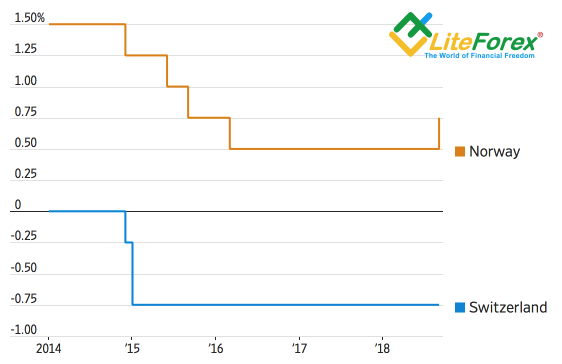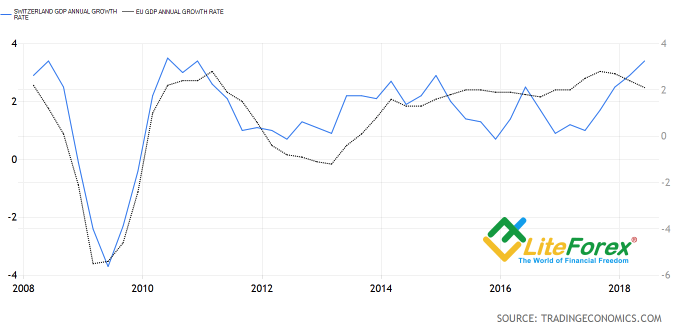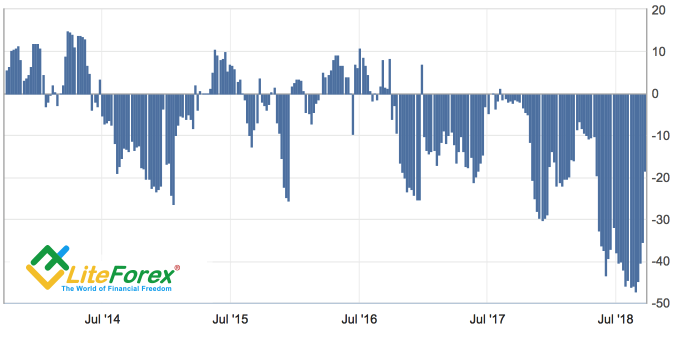Forming positions in the USD/CHF and EUR/CHF depending on the results of the Fed meeting and the draft Italian budget
The Swiss franc quietly topped the list of the best performers of the year among the G10 currencies and claims the role of the most interesting currency of the last week of September. The FOMC meeting and presentation of the draft budget of Italy are capable of rocking the USD/CHF and EUR/CHF boats. Dovish rhetoric of Jerome Powell, coupled with the unwillingness of eurosceptics to comply with the requirements of the EU will accelerate the process of closing down speculative long positions in the US dollar and will increase political risks in the Old World. In such an environment, fans of the Swissie feel like a fish in the water.
Slow but steady wins the race. The SNB, unlike other European central banks, does not intend to hurry with the normalization of monetary policy. This is indicated by a reduction in its inflation forecast from 0.9% and 1.6% to 0.8% and 1.2% in 2019-2020. While the Bank of Norway raised the rate, the Bank of England continues the normalization cycle, and Riksbank, most likely, will begin it this year, the Swiss regulator says its passivity is due to the sluggish inflation.
Dynamics Central Banks Rates In Norway, Switzerland
Source: Wall Street Journal.
The slow pace of the SNB is due to the reluctance to allow further revaluation of the franc. Since the beginning of the year, it has added about 3.5% against the euro - the currency of its main trading partner, which has a negative impact on the positions of Swiss exports. Along with a favorable external background, the strong economy has become the reason for the strengthening of the Swissie. In the second quarter, it grew by 3.4% y / y, which is the fastest growth since the end of 2010. Against the background of the unimpressive start of the currency block economy, the success of the EUR/CHF bears seem to be a regularity, and the fall of the pair below the region of 1.11-1.12 is certainly holding back the currency interventions of the National Bank.
Dynamics Of GDP In Switzerland, Eurozone
Source: Trading Economics.
Neither the SNB nor the OECD expect the situation to change in the second half of the year. The Swiss regulator raised its forecast for GDP growth this year from 2.5% to 3%, while the OECD believes that the eurozone economy will grow by 2% and 1.9% in 2018-2019. In May, the figures were 2.2% and 2.1%. A strong labor market (unemployment fell to the lowest levels since the global financial crisis) and a healthy economy strengthen the risks of monetary policy normalization and help reduce the speculative short positions in the franc from their record highs that took place in late August more than two times. Yes, the SNB is in no hurry due to the inflation, but the Fed began normalizing long before the PCE reached 2%, and Mario Draghi signaled about it in the summer of 2017 in Portuguese Sintra at a time when consumer prices in the euro zone were growing at about the same rate as now in Switzerland.
Dynamics Of Speculative Franc Positions
Source: CFTC, Investing.
In my opinion, the continued taking of profits in the dollar after the meeting of the FOMC and the problems with the draft Italian budget will increase the risks of a continuing journey south of the USD/CHF towards 0.938 and 0.929. Improvement of the political landscape in the south of the euro zone will help the EUR/CHF consolidate around 1,12-1,15.
